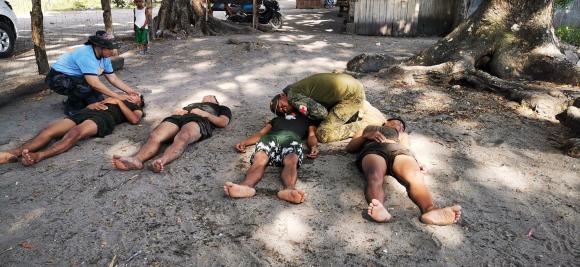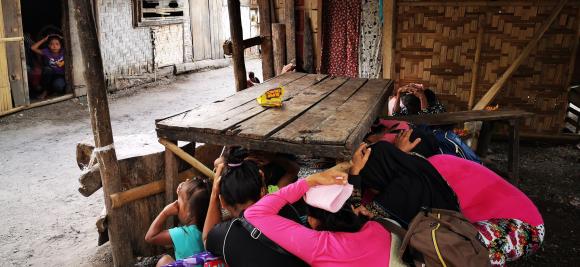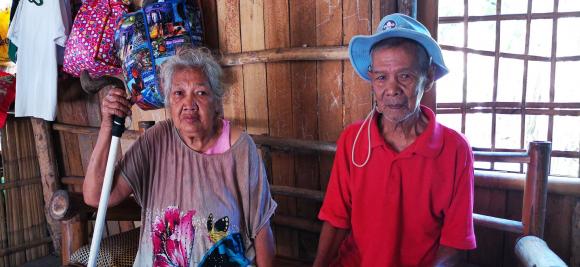1976 quake in Mindanao remembered, BARMM holds preparedness drill
KUSIONG, Datu Odin Sinsuat, Maguindanao - Ricardo Fering, 81 and his wife, Lourdes, 80 could still vividly recall what went through at past midnight of August 17, 1976.
The couple was living at that time in Minandar, an uphill community fronting the Kusiong village and the seashore. They have only five children during that year until their relocation now in Kusiong and blessed with 14 children.
“That was a very strong quake, our cat in the house don’t know where to go as our hut was like a hammock in full swing,” said Lourdes in Tagalog.
“The next morning, as we attempted to visit our relatives and tried to go out to Cotabato City I saw dead people, fish scattered along the road,” Ricardo recalled.
That was 43 years ago but remained clear in the mind of Liia Suban, 67, a resident also of Mindanar. She said that major quake was followed by thousands of aftershocks.
“Just after the earthquake, a loud grumbling of rocks could be heard, it was like a war, rocks falling from the hill and unusual strong wave could be heard slapping not for from our location,” she narrated.
“It was three days after when the news spread in the village that a tsunami hit the coastline of Moro Gulf and has killed thousands of people, which they only described then as “Tidal Wave.”
Government responses took days to clear roads due to poor communication by that time, Ricardo said.
According to Engr. Rainier Amilbahar of the Philippine Institute of Volcanology and Seismology in Cotabato City and BARMM, the Celebes fault that created the strong earthquake and produced tsunami in 1976 has been consistently active since year 1600.
“That is why we have to be always ready,” Amilbahar said.
A report prepared for the Special Committee on Tsunami Warning System of the National Committee on Marine Sciences of the National Science and Development Board and completed in 1978 as reported by Mindanews in 2011.
It revealed that tsunami affected 700 kilometers of coastline bordering the Moro Gulf, affecting the coastal areas of Maguindanao, Sultan Kudarat, Lanao del Sur, Lanao del Norte, Zamboanga del Sur, Basilan, Sulu and the cities of Cotabato, Zamboanga and Pagadian.
Maguindanao posted the highest number of dead and missing, followed by Lanao del Sur, the report said.
About 8,000 were reported killed or missing. About 10,000 were injured and about 90,000 were homeless.
The report also said that 95 percent of the casualties were due to the tsunami. The waves ranged from 4.3 meters (14 feet) to nine meters (29 feet).
Waves were reported to be higher than five meters in Linek and in Kalanganan in Cotabato City, Pagadian City, Sacol Island in Zamboanga City.
On Saturday, Rapid Emergency Action on Disaster Incidents (READI-BARMM) conducted earthquake and tsunami drills as part commemoration of the deadliest calamity that hit the country.
As the whistles start to draw the air around the coastal village around 7am on Saturday, residents applied what they learned from previous disaster drills, that is to duck, hold and cover.
And as situation calms down, hundreds of villagers flocked towards Bai Hanina Sinsuat High School ground designated as the evacuation site by the organizers of RAPID-BARMM.
By this time, a chopper hovering around could be heard conducting assessment and rescue, and speed boats from Philippine Navy, Coastguard and different rescue teams acted to a drowning scenario of a capsized boat in the middle of Moro Gulf.
Minutes later, everybody was seen busy.
Ambulances, rescuers and hospital staff came, to conduct rescue of estimated 50 casualties, some of them portrayed dead from strong earthquake and followed by tsunami.
It was all coordinated effort, like a festival of rescue teams and medical staff gathered from devastation area to evacuation and treatment ground.
Assessment
After more than hour of exercise, assessment and evaluation were made by different agencies and the Mindanao Humanitarian Team (MHT), composed of International NGO’s and the Phivolcs.
Amilbahar, noticed that an indigenous and signature warning device of the Teduray’s was not practiced since the first tsunami simulation in 2014.
“Let’s bring back the bamboo bell hanged in every houses as early warning device. That strategy has been emulated by other areas, we were the first of that and has been effective warning device even before the whistles and sirens”, he said.
Among other observations made by MHT, not all are participating. In one instance, a uninformed fish vendor was still doing business in the middle of busy simulation.
A poor communication signal that suggests stronger and organized UHF and VHF signal or a satellite phone from the responders is needed during this type of disaster.
Some of the participants was carried away by the presence of chopper that instead of portraying their roles, they watch the helicopter activity.
The tagging issues of severely and mild affected casualties is also a discussion of responders and among others discrepancies.
But there are good practices also that were observed. Example was the “Go Kit” of those who acted as evacuees where food, personal hygiene and emergency kit, diaper, napkin, water, personal documents like birth certificate and passports are all intact in their bags.
Observers lauded the spacious evacuation site which immediately identified the areas of evacuation and treatment area as well as the conduct of psycho-social activities for children.
Responders became creative that the lack of stretchers did not hamper them from hauling injured residents using sliced woods put together as carriers.
Expanded Network of Disaster response
Minister Naguib Sinarimbo of Bangsamoro Autonomous Region in Muslim Mindanao of Ministry of Interior and Local Government (MILG-BARM) who also heads the disaster response bureau, READI-BARMM, said the exercise aims to save lives in times of calamities.
The activity aims to institutionalize disaster response.
“Our simulation is integration of responses from LGU to barangays, it’s a vertical and horizontal integration,” he said. (Ferdinandh Cabrera)



